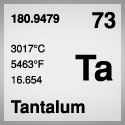
ONE OF THE MOST CORROSION RESISTANT MATERIALS AVAILABLE, EXHIBITS RESISTANCE TO ACID ATTACK COMPARABLE TO GLASS.
Tantalum is corrosion resistant, due to a tenaciously adherent oxide film akin to the entire family of passive, reactive metals. The metal has gained acceptance for use in electronics, missile technology, the chemical industry and the medical field. Tantalum is immune to attack by many acids and salt solutions. It is, however, subject to hydrogen embrittlement in alkaline solutions. It is used to fabricate heat exchangers, reaction vessels, bayonet heaters, thermo wells, surgical implants and radiation shielding. Tantalum should not be used in air at temperatures above about 300°C because of severe oxidation.
PROPERTIES
Tantalum is one of many transition elements located in group 5 of the periodic table. It is a gray, heavy metal and is very corrosion resistant.
- Atomic No. 73
- Atomic Wt. 180.9479
- Specific Gravity 16.654
- Melting Point 2996˚C
- Coefficient of Thermal Expansion 6.5 X 10-6/°K
- Specific Heat 0.033 cal/g/°K
- Ultimate Tensile Strength (Room Temperature, Annealed) 41 ksi
- Yield Tensile Strength (Room Temperature, Annealed) 25 ksi
- Poisons Ratio 0.35
- Modulus of Elasticity 27 X 106 psi
- Recrystallization Temperature 900˚C–1200˚C
GENERAL CORROSION RESISTANCE
Tantalum is one of the most corrosion resistant ductile metals exhibiting resistance to mineral acids except hydrofluoric acid, acid solutions containing fluoride ions, or free sulfur trioxide and is embrittled by alkaline materials. It is resistant to many molten metals, including lithium and sodium-potassium.
This data is based on laboratory testing only. Your in-plant results may differ. Testing is recommended under other conditions as needed.
CORROSION RESISTANCE OF TANTALUM
Tantalum's resistance to corrosion by many materials is exemplified in the following Corrosion Resistance Table.
|
SUBSTANCE |
REACTION |
|
|
Acetic Acid |
20-392° (68-738°F), all concentrations: No attack |
|
|
Air or Oxygen |
At room temperature: practically stable Above 600°C (1112°F): formation of protective surfaces of Ta oxides |
|
|
Aqueous Ammonia |
Practically no attack |
|
|
Aqua Regia |
Cold and hot: practically no attack |
|
|
Carbon (Graphite) |
At high temperatures: carbide formation |
|
|
Carbon Dioxide |
Above 1200°C (2912°F): oxidation |
|
|
Carbon Monoxide |
At red heat: reaction (absorption of C and O) In high vacuum above 1400°C: formation of CO |
|
|
Chromic Chloride Acid |
20-100°C (68-212°F), concentrated: no attack |
|
|
Aqueous Caustic |
Cold: practically stable Hot: noticeable attack |
|
|
Molten Caustic |
Stable |
|
|
Chlorine |
at 250°C (464°F): beginning attack Above 450°C (842°F): violent reaction |
|
|
Ferric Chloride |
19°C (66°F) Boiling, 5-30% concentration: no attack |
|
|
Hydrocarbons |
Above 800-1000°C (1472-1832°F): carbide formation Above 1400°C (2552°F): complete carburizing |
|
|
Hydrochloric Acid |
Cold and Hot: no attack |
|
|
Hydrofluoric Acid |
Strong Attack |
|
|
Hydrofluoric and Nitric Acid |
Rapid dissolution |
|
|
Hydrogen |
Above 300-400°C (572-752°F): formation of hydride Above 1000°C (1832°F): very slight solubility of hydrogen In high vacuum above 600-700°C (1112-1292°F): evolution of hydrogen |
|
|
Hydrogen Peroxide |
Concentrated: good resistance to attack |
|
|
Hydrogen Sulfide |
At red heat: sulfide formation |
|
|
Nitric Acid |
Cold and Hot: no attack |
|
|
Nitrogen |
Up to 150°C (302°F): no attack Above 800°C (1472°F): nitride formation |
|
|
Oxalic Acid |
20-96°C (68-205°F), saturated: no attack |
|
|
Phosphoric Acid |
85% concentration, 145-210°C (293-410°F): no attack |
|
|
Potassium Hydroxide |
110°C (230°F), 5% concentration: no attack |
|
|
Sodium Hydroxide |
100°C (230°F), 5% concentration: no attack 100°C (230°F), 40% concentration: rapid attack |
|
|
Steam |
At red heat: rapid oxidation |
|
|
Sulfur Dioxide |
Up to 300°C (572°F): stable |
|
|
Sulfuric Acid |
Cold and hot: no attack |
|
|
Molten Metals: |
||
|
Sodium |
Up to 1200°C (2192°F): resistant |
|
|
Magnesium |
Up to 1150°C (2102°F): resistant |
|
|
Lithium, Potassium, Lead |
Up to 1000°C (1832°F): resistant |
|
|
Bismuth |
Up to 900°C (1652°F): resistant |
|
|
Mercury |
Up to 600°C (1112°F): resistant |
|
|
Zinc |
Up to 500°C (932°F): resistant |
|
|
Gallium |
Up to 450°C (842°F): resistant |
|
|
Refractory Oxides: |
||
|
Alumina |
Up to 1900°C (3452°F): stable |
|
|
Beryllia |
Up to 1900°C (2912°F): stable |
|
|
Magnesia |
Up to 1800°C (3272°F): stable |
|
|
Zirconia |
Up to 1600°C (2912°F): stable |
|
|
Thoria |
Up to 1900°C (3452°F): stable |
|
